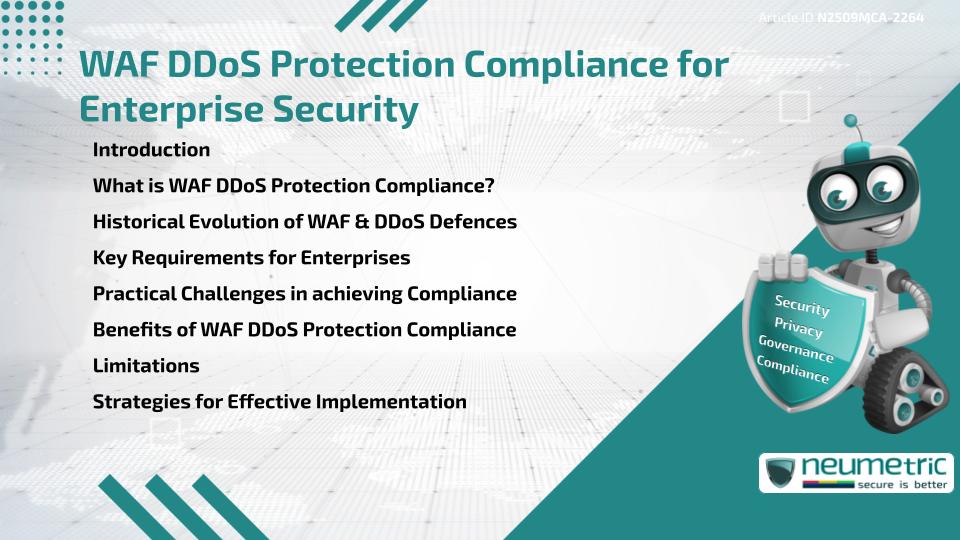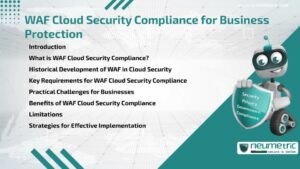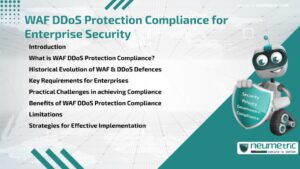Table of Contents
ToggleIntroduction
WAF DDoS Protection Compliance is vital for Enterprises that rely on Digital Platforms & Cloud Services. A Web Application Firewall [WAF] helps filter malicious traffic, while Distributed Denial of Service [DDoS] Protection ensures System availability during Large-scale Attacks. Compliance means adopting controls & practices that align with Security Frameworks & Legal obligations, protecting both Customers & Business Operations.
What is WAF DDoS Protection Compliance?
WAF DDoS Protection Compliance refers to implementing & maintaining measures that Safeguard Applications from Cyberattacks while meeting Regulatory requirements. These measures include blocking Malicious requests, mitigating Traffic Floods & Documenting Compliance with Standards such as ISO 27001, PCI DSS & GDPR. It ensures Enterprises not only deploy defences but also demonstrate Accountability during Audits.
Historical Evolution of WAF & DDoS Defences
Early Firewalls in the 1990s were designed to protect Networks but lacked Application-layer visibility. The rise of Web Applications led to WAF development, capable of filtering SQL Injection & Cross-site Scripting Attacks. Meanwhile, DDoS Attacks became more sophisticated, moving from basic Bandwidth floods to Multi-vector assaults. Regulators & Industry Frameworks later mandated stronger controls, making WAF & DDoS defences part of Compliance Requirements.
Key Requirements for Enterprises
To achieve WAF DDOS Protection Compliance, Enterprises must:
- Deploy WAF Solutions capable of inspecting Application Traffic
- Implement DDoS mitigation Systems with Real-time Monitoring
- Maintain Incident Response & Escalation procedures
- Conduct regular Penetration Tests & Vulnerability Scans
- Keep detailed Audit Logs to demonstrate Compliance Readiness
Guidance from NIST & ENISA provides further technical Best Practices.
Practical Challenges in achieving Compliance
Organisations face several obstacles. Legacy Applications may not integrate well with modern WAF Solutions. DDoS mitigation requires substantial investment in Bandwidth & Cloud-based scrubbing Services. Smaller Enterprises often struggle with the cost of Continuous Monitoring & Staff Training. Additionally, Compliance Audits can be Time-consuming when Systems lack Centralised logging.
Benefits of WAF DDoS Protection Compliance
Despite these challenges, Compliance offers clear benefits:
- Stronger resilience against disruptive Cyberattacks
- Improved Uptime & Customer Trust in Digital Services
- Easier demonstration of Regulatory Compliance
- Reduced Financial & Reputational damage from outages
- Streamlined Incident Response through documented processes
Limitations
Critics point out that WAF & DDoS solutions are not foolproof. Advanced Attackers may bypass Protections or Exploit Zero-day Vulnerabilities. Over-reliance on Technology without strong Governance may create blind spots. Furthermore, costs can be prohibitive for smaller businesses, raising questions about proportionality of Compliance Requirements.
Strategies for Effective Implementation
Enterprises can strengthen Compliance by:
- Using Hybrid Models that combine On-premises & Cloud-based defences
- Regularly updating WAF rules to counter emerging Threats
- Integrating DDoS monitoring with Security Operations Centers [SOCs]
- Training staff on Incident Response & Compliance reporting
- Referencing global Frameworks like OECD Privacy guidelines & World Bank Governance insights
Takeaways
WAF DDoS Protection Compliance is both a defensive necessity & a regulatory requirement. By combining Technical defences with Governance, Audits & Training, Enterprises can achieve resilience, protect Customers & Strengthen long-term Security Posture.
FAQ
What is WAF DDOS Protection Compliance?
It is the process of implementing WAF & DDoS Controls while meeting Regulatory & Industry Standards.
Why is it important for Enterprises?
It protects Systems from Attacks, ensures uptime & demonstrates Accountability to Regulators & Customers.
What are the key Compliance Requirements?
Deploying WAF, DDoS mitigation, Incident Response plans & detailed Audit Logging.
What challenges do businesses face?
Integration with Legacy Apps, High Costs & Resource limitations for Continuous Monitoring.
Does Compliance guarantee full Protection?
No, but it significantly reduces Risks & Strengthens resilience against most Attack Vectors.
References
- ISO 27001 – Information Security
- NIST CyberSecurity Framework
- ENISA – European Union Agency for CyberSecurity
- OECD Privacy Guidelines
- World Bank Digital Development
Need help for Security, Privacy, Governance & VAPT?
Neumetric provides organisations the necessary help to achieve their CyberSecurity, Compliance, Governance, Privacy, Certifications & Pentesting needs.
Organisations & Businesses, specifically those which provide SaaS & AI Solutions in the Fintech, BFSI & other regulated sectors, usually need a CyberSecurity Partner for meeting & maintaining the ongoing Security & Privacy needs & requirements of their Enterprise Clients & Privacy conscious Customers.
SOC 2, ISO 27001, ISO 42001, NIST, HIPAA, HECVAT, EU GDPR are some of the Frameworks that are served by Fusion – a SaaS, multimodular, multitenant, centralised, automated, CyberSecurity & Compliance Management System.
Neumetric also provides Expert Services for technical Security which covers VAPT for Web Applications, APIs, iOS & Android Mobile Apps, Security Testing for AWS & other Cloud Environments & Cloud Infrastructure & other similar scopes.
Reach out to us by Email or filling out the Contact Form…





